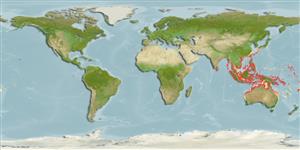Teleostei (teleosts) >
Gobiiformes (Gobies) >
Gobiidae (Gobies) > Gobiinae
Etymology: Amblyeleotris: Greek, amblys = darkness + The name of a Nile fish, eleotris (Ref. 45335).
More on author: Bleeker.
Environment: milieu / climate zone / depth range / distribution range
Ecology
Marine; brackish; reef-associated; amphidromous (Ref. 51243); depth range 5 - 35 m (Ref. 90102). Tropical
Indo-West Pacific.
Size / Weight / Age
Maturity: Lm ? range ? - ? cm
Max length : 14.0 cm TL male/unsexed; (Ref. 2272)
Dorsal spines (total): 6 - 7; Dorsal soft rays (total): 17 - 19; Anal spines: 1; Anal soft rays: 18 - 20. Similar to A. macronema in color pattern but has more dorsal and anal rays (Ref. 37816).
Characterized by whitish or pale grey color; presence of dark brown stripe from behind the eye to upper edge of gill cover; five wide , diffused brown bars on side; brown scribbling on upper half of body between bars; pelvic fins united by membrane at base of fifth soft ray; without median predorsal scales; longitudinal scale series 120-130; greatest depth of body 6.3-7.0 in SL; lanceolate caudal fin, about twice the head length (Ref. 90102).
Occurs in coastal sand slopes (Ref. 8631). Found in mangroves and bays (Ref. 4833). Found in coastal sand slopes and estuaries and usually at moderate depth of about 20 meters on deeper slopes (Ref. 48637).
Life cycle and mating behavior
Maturities | Reproduction | Spawnings | Egg(s) | Fecundities | Larvae
Kailola, P.J., 1991. The fishes of Papua New Guinea: a revised and annotated checklist. Vol. III. Gobiidae to Molidae. Research Bulletin No. 41, Research Section, Dept. of Fisheries and Marine Resources, Papua New Guinea. 153 p. (Ref. 6771)
IUCN Red List Status (Ref. 130435)
Threat to humans
Harmless
Human uses
Fisheries: of no interest; aquarium: commercial
Tools
Special reports
Download XML
Internet sources
Estimates based on models
Preferred temperature (Ref.
123201): 25.2 - 29.1, mean 28.3 °C (based on 594 cells).
Phylogenetic diversity index (Ref.
82804): PD
50 = 0.5000 [Uniqueness, from 0.5 = low to 2.0 = high].
Bayesian length-weight: a=0.00708 (0.00333 - 0.01504), b=3.09 (2.92 - 3.26), in cm total length, based on LWR estimates for this (Sub)family-body shape (Ref.
93245).
Trophic level (Ref.
69278): 3.4 ±0.4 se; based on size and trophs of closest relatives
Resilience (Ref.
120179): High, minimum population doubling time less than 15 months (Preliminary K or Fecundity.).
Fishing Vulnerability (Ref.
59153): Low vulnerability (10 of 100).
Nutrients (Ref.
124155): Calcium = 105 [49, 193] mg/100g; Iron = 0.674 [0.337, 1.271] mg/100g; Protein = 18.2 [16.3, 19.9] %; Omega3 = 0.0978 [, ] g/100g; Selenium = 25.5 [11.8, 64.3] μg/100g; VitaminA = 108 [30, 355] μg/100g; Zinc = 2.07 [1.36, 3.06] mg/100g (wet weight);
